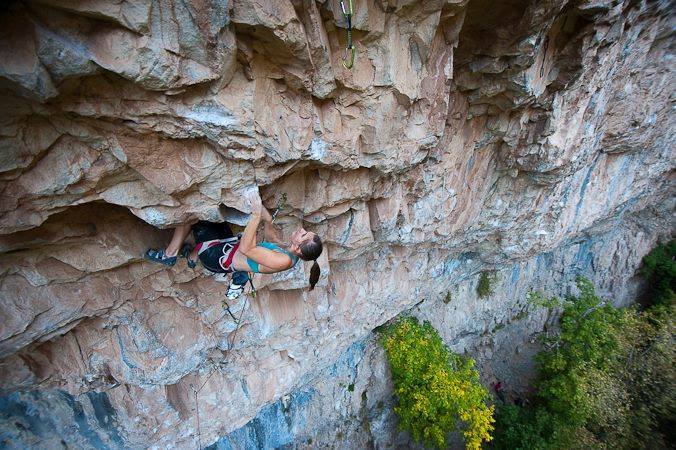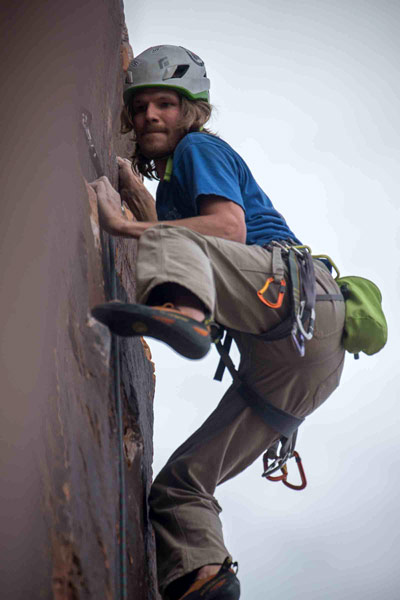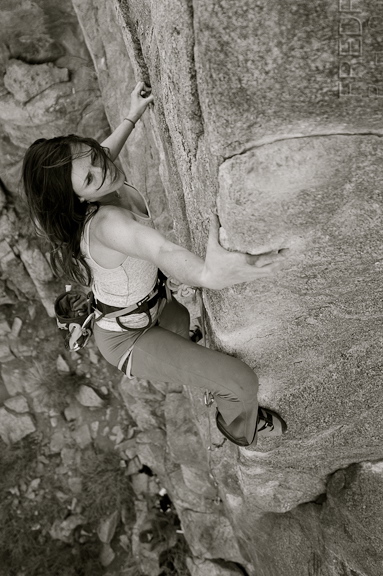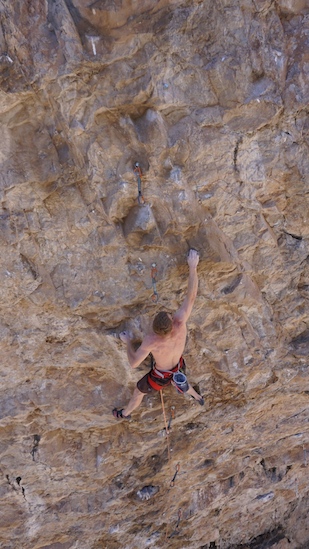Muscles are Weak Without the Mind

Jen Vennon Bisharat unlocks Stockboy’s Revenge (5.14b) in Rifle Mountain Park. Photo by Andrew Bisharat.
Stronger. I just need to get a little stronger.
Bullshit.
Why do so many climbers jump to this conclusion when they find their performance plateauing on a project? Probably because it’s easier and more straightforward to build bigger muscles than a stronger mind.
Recovering from open-heart surgery in the last five months has opened my eyes about some things, such as my tendency to rely on raw muscle power to carry me up my hardest projects. Since I started climbing again on Feb. 11, I’ve come to realize how much more technique counts than muscle fitness.
I asked some of the best climbers I know who are masters of mental focus and technique – Jen Vennon Bisharat, Heather Weidner and Steve Damboise – to share their thoughts on the subject.
Mind Over Muscle
“Technique counts for a lot more than raw strength,” said Vennon, 32, who was the first woman to officially tick 5.14b in the hardman bastion of Rifle Mountain Park when she sent Stockboy’s Revenge in 2011.
“I basically think that technique will take you a whole lot further than most people give it credit for,” Vennon continued. “I also think there’s a lot to the mental part of climbing that goes unnoticed. Visualization and mental rehearsal helps me a lot, as well as relying on muscle memory when I get pumped and tired. It’s interesting that a lot of mental strength comes from not over-thinking things.”
“Lastly, remembering your own beta and all the micro adjustments necessary to perform it is super important,” she added. “I can’t tell you how often I see people waste effort just forgetting the beta! I believe visualization comes into play at that point.”
Weidner, 34, who recently dispatched Stockboy’s Revenge as well, shared some similar thoughts as Vennon.
“Climbing is not all about being physically strong,” Weidner said. “This is what I love about the sport – our success is largely dependent on our mental strength. I find this fulfilling, otherwise I might consider becoming a meat-headed weight lifter in the gym. That being said, the mind can be your greatest asset or biggest weakness in projecting a difficult rock climb. Projecting a route at your physical limit involves failing. A lot. How you deal with repeated failure is what ultimately determines your outcome.”
Weidner went on to share how the death of her mother affected her when she was a teenager. She said a quote from Walt Disney is one of her favorites: “All the adversity I’ve had in my life, all my troubles and obstacles, have strengthened me … You may not realize it when it happens, but a kick in the teeth may be the best thing in the world for you.”
“These kinds of traumatic events and hardships in life can destroy you, and you can live the rest of your life as a victim. Or they can make you tougher and stronger,” Weidner said.
She said it’s not necessary to have tremendous hardship in order to succeed, but it does prepare your mind to deal with difficulty.
“In a world of Instagram and insta-gratification, we sometimes forget that anything worth doing often takes time and effort,” she said. “I see so many strong and talented rock climbers shy away from routes as soon as it takes more than a few tries. They’ll say they need to come back to it after they train harder, or just say something like they don’t like the style and avoid it altogether.”
“But physical strength isn’t everything,” Weidner affirmed. “I’m certainly a far stretch from being one of the strongest climbers, but what I do have is the mental ability to deal with repeated failure, and I know how to work hard.”
‘Over the Top’
At nearly 50 years old, Steve Damboise has had a hand in establishing some of Rifle’s hardest routes for 20 years. He continues to send 5.14 every year, and I often see him in Rifle’s Wicked Cave, cranking to the edge of his physical ability 100 percent of the time. He just never gives up in any moment. I’ve seen him send when it looked like he was going to fall off any move for twenty moves in a row. His mind doesn’t let go, and neither does his body. This guy is a shining example of what it means to “try hard.”
“Mental focus requires an extreme, almost aggressive, attitude and mindset,” Damboise said. “You need to become over-the-top committed to the goal and the journey to achieve it. I have self-diagnosed myself with ADHD – I am thinking about a million things at a million miles an hour in life. However, when it comes to working on sending my route, it can switch my mind and attention fully to this one goal that incorporates so many variables.”
Tenacity is important.
“Never give up, no matter how painful or impossible it seems in the moment,” he said. “Tell yourself you can do it, and it will happen in time.”
Looking Forward
I relate to so much of what these rock masters have shared.

The author onsights Fernando (5.11b) in Moab, five months after open-heart surgery. Photo by Gregg Trawinski.
When I came back from surgery on Feb. 11, I didn’t know what to expect. I was prepared to be stuck on easy slabs for a while. How could I expect to handle steep limestone sport routes when I couldn’t do two complete pull-ups? Instead, on my first day back (on toprope), I floated two overhanging routes, which I know very well – a 5.11c and a 12a. They felt so good I did the 12a again that day.
I still can’t do much more than three pull-ups, but I’ve been climbing regularly up to 12c at Rifle since then. Granted, I have these routes very dialed from climbing them so many times over the years, but that is exactly my point: Mind over muscle.
To paint the picture a little better, these “workouts,” as I call them, are actually rather mild in my opinion. I’m rarely falling or resting on the rope, yet I am trying to be very conservative about how much I exert myself. So I’m not falling, but I’m not reaching the point where I have to yell and grunt to bust a move.
Shoot, if I can feel this solid on these routes in spite of how weak my body is, I should have been sending 5.14 before surgery, considering how strong I was! (Right before surgery I was one-hanging a couple different 13d’s.)
Though my heart surgery set me back a bit in terms of physical fitness, I do feel that my mind has been strengthened. Goals have been clarified, as well as that sweet sense of passion for what I do. And a little voice inside tells me I can, and will, do it better than ever before.
That’s a powerful feeling – unlocking your potential.
It’s thrilling to consider that what I learn through climbing often bleeds into the rest of my life.
Derek Franz writes a blog for SplitterChoss.com once a month. To find more of his writing, including “The Open Heart Series,” which details his heart surgery and recovery, visit www.derekfranz.com.
4 Responses to Muscles are Weak Without the Mind
Bulldog Creek Dog Walk (IV WI 4+)
Hayden Carpenter and Tom Bohanon recently repeated an obscure ice climb on the south side of Mt Sopris. Given a brief mention in Jack Robert’s ice guide, Bulldog Creek Walk is described as being 100 meters of WI 4. What they found was seven pitches of ice in a remote setting that makes for one […]
Connect with Us

















So thrilling to read this as I get to know some of your climbing friends. The women amaze me. They are living testimony that we are not the weaker sex. I admire everyone who puts themselves out there to pursue their passion, and that includes YOU!
Thanks, Betty.
Great article – thanks for this! I’m currently trying to practice two things on the wall – breathing and mental focus.
I’ve noticed recently that small things can put me off, and make me fail before I’ve even started, and reading this article has given me a little more inspiration and put the work in to build on my mental focus / tenacity.
Thanks, Paul. Good luck with the training!